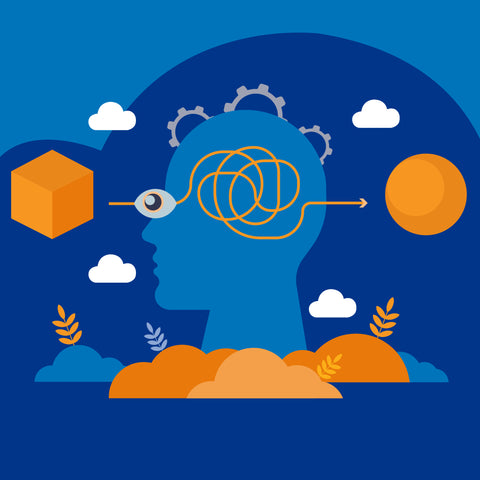
Our mission at Troscriptions is to give you freedom. Freedom from your lack of productivity and focus (Blue Cannatine), freedom from your lack of energy and resilience (Just Blue), and freedom from your anxiousness and stress (Tro Calm).
Although the title of this article may seem like a departure from our regularly scheduled (and we think awesome) programming... it is, in fact, very relevant.
Because with this newfound enhanced sense of freedom you feel from your favorite Tx, you'll be able to show up and live up to your true potential... or will you?
As The Who said in 1971, "meet the new boss, same as the old boss"... especially if you don't mind your cognitive biases. Said another way: You'll likely fall into the same traps without awareness of your cognitive biases.
In brief, cognitive biases (or cognitive errors) are systematic deviations from rational or normative judgement, based on a person’s “subjective” interpretation of an input. Cognitive biases can therefore affect perception, judgement, and interpretation of a given phenomenon.
The list of cognitive biases is continually evolving, based on the previous six decades of research and exploration of human decision-making and judgement.
In this article, we’re going to take a closer glimpse at some of the top cognitive biases you’re likely to come across (or be vulnerable to!) and pull them apart with the latest research evidence.
Confirmation Bias
Confirmation bias is where a person’s existing beliefs and values tend to influence their search, selection, analysis, interpretation, and recall of information. This is particularly the case for deeply held or emotionally charged beliefs, to the extent that people will ignore contradictory information whilst favoring evidence that supports their own preconceived notions.
Confirmation bias is omnipresent in psychology, economics, politics, media, and in the scientific and medical disciplines as well [3-6].
Sunken Cost Fallacy
Sunken cost fallacy is a phenomenon in which the prior investment of money, time, and/or effort into a given endeavor influences a person’s decision-making (usually increasing the likelihood of them continuing in an enterprise when they perhaps should abandon it) [7]. In economic and financial settings, this has tremendous implications. The Nobel Prize winner Daniel Kahneman is well-celebrated for his work in this area, and his superb book “Thinking, Fast and Slow” is hugely recommended.
A famous example of this would the Lockheed Martin F-35 Lightning II, the "Joint Strike Fighter" program that has cost the US Air Force $1.6 trillion, with investors and the government believing that the exorbitant (and spiraling!) costs justified the continuation of the program. To this day, it is still the most expensive military procurement in history.
In human relationships, sunken cost fallacy would best describe a person continuing to remain in an unhappy marriage or relationship, owing to the length of time, effort, and investment already placed into the other person [8].
The Halo Effect
A term coined by Edward Thorndike, the "halo effect" is a cognitive bias that describes the tendency for positive impressions of a person or entity in one area to positively or negatively influence a person’s feelings or opinion in other aspects. That is to say, it is the global evaluation of a person or entity based on a single trait [9,10].
The halo effect has been studied for over a century, and is perhaps best illustrated by the tendency to regard more attractive people in a more positive light [11] and associate attractiveness with academic performance and competence [12].
Groupthink
The groupthink phenomenon is a socially-driven psychological bias whereby the necessity to maintain harmony within a group setting surpasses rational and functional decision-making [13]. In essence, group cohesiveness and agreement is placed ahead of critical evaluation and insight, leading to low conflict and the sidelining of important and/or controversial issues.
The term "groupthink" was coined by Irving Janis to depict this premature consensus-seeking in highly cohesive groups, a phenomenon known to affect corporate settings as well as healthcare environments [14,15].
Swimmer’s Body Illusion
The swimmer’s body illusion refers to the confusion of selection factors with results, or rather the mistaken belief that certain outcomes are caused by specific activities when in reality those outcomes may be underpinned by pre-existing factors.
Swimmer’s body is the oversimplification of a phenomenon, for instance the wrongful assumption that a professional athlete or model has an enviable physique due to the aesthetic gym clothing that they are wearing in an advertisement.
Sampling and/or Selection Bias
Sampling and/or selection bias occurs when inaccurate conclusions are drawn due to the improper selection of individuals, groups, or data whereby adequate randomization is not attained. Therefore, the population that is intended to be analyzed in the dataset is not represented by the recruited sample. The subsequent statistical analysis and any interpretations of this are then distorted [16,17].
There are additional aspects that are involved in selection bias, particularly in the context of medical research. Not only is the selection of representative subjects of vital importance, but the selection and allocation of subjects to given exposures is also an integral aspect of study design to mitigate this bias [18].
The Dunning-Kruger Effect
A famous cognitive bias (and our favorite... see below), the Dunning-Kruger effect is the tendency for people with low expertise, knowledge, or insight on a given area or topic to overestimate their ability or knowledge [19]. That is, self-assessments of ability or proficiency do not align with objective measurements of the same. In simple terms, it has been described as "being ignorant of one’s own ignorance" [20].
David Dunning and Justin Kruger performed the initial study in 1999 with a focus on logical reasoning, grammar, and social skills. Since then, the effect has been noted across many diverse fields of expertise, such as finance, business, politics, medicine, and others.
Many great examples can be found in the wonderful world of health influencers on Instagram and other social media platforms. These individuals often offer advice or promote products that have not been scientifically proven as effective or safe. In some cases, this can result in harmful or even dangerous outcomes for their followers.
For example, some influencers may promote fad diets or detox cleanses that can lead to nutrient deficiencies or dehydration. Others may tout the benefits of unproven supplements or alternative medicine without acknowledging the lack of evidence supporting their claims. As consumers of health and wellness content, it is important to evaluate the qualifications and credibility of influencers before accepting their advice, and seek guidance from trained professionals whenever possible.
Did you know that there are 4 practicing physicians on the Troscriptions team? Dr. Ted, our head MD, founder, and chief Daydreamer has another term for the Dunning-Kruger effect in the health and wellness world: "chauffeur information," i.e., information from people who only have a vague or superficial knowledge of what they are talking about.
This is especially true for those giving clinical recommendations (take this, do that, don't do that, etc.) but do not actually see patients.
Our advice? Buyer beware! Do you best to check your cognitive biases at the door or before opening that new tab on your browser.
References
[1] E.D. O’Sullivan, S.J. Schofield, Cognitive bias in clinical medicine, J R Coll Physicians Edinb. 48 (2018) 225–232. https://doi.org/10.4997/JRCPE.2018.306.
[2] G. Saposnik, D. Redelmeier, C.C. Ruff, P.N. Tobler, Cognitive biases associated with medical decisions: a systematic review, BMC Med Inform Decis Mak. 16 (2016) 138. https://doi.org/10.1186/s12911-016-0377-1.
[3] A.E. Allahverdyan, A. Galstyan, Opinion dynamics with confirmation bias, PLoS One. 9 (2014) e99557. https://doi.org/10.1371/journal.pone.0099557.
[4] R.S. Nickerson, Confirmation Bias: A Ubiquitous Phenomenon in Many Guises, Review of General Psychology. 2 (1998) 175–220. https://doi.org/10.1037/1089-2680.2.2.175.
[5] I. Eli, Reducing confirmation bias in clinical decision-making, J Dent Educ. 60 (1996) 831–835.
[6] S. Satya-Murti, J. Lockhart, Recognizing and reducing cognitive bias in clinical and forensic neurology, Neurol Clin Pract. 5 (2015) 389–396. https://doi.org/10.1212/CPJ.0000000000000181.
[7] R. Parayre, The strategic implications of sunk costs: A behavioral perspective, Journal of Economic Behavior & Organization. 28 (1995) 417–442. https://doi.org/10.1016/0167-2681(95)00045-3.
[8] S. Rego, J. Arantes, P. Magalhães, Is there a Sunk Cost Effect in Committed Relationships?, Curr Psychol. 37 (2018) 508–519. https://doi.org/10.1007/s12144-016-9529-9.
[9] G. Gabrieli, A. Lee, P. Setoh, G. Esposito, An Analysis of the Generalizability and Stability of the Halo Effect During the COVID-19 Pandemic Outbreak, Front Psychol. 12 (2021) 631871. https://doi.org/10.3389/fpsyg.2021.631871.
[10] M. Gräf, C. Unkelbach, Halo Effects in Trait Assessment Depend on Information Valence: Why Being Honest Makes You Industrious, but Lying Does Not Make You Lazy, Pers Soc Psychol Bull. 42 (2016) 290–310. https://doi.org/10.1177/0146167215627137.
[11] L.A. Zebrowitz, R.G. Franklin, The attractiveness halo effect and the babyface stereotype in older and younger adults: similarities, own-age accentuation, and older adult positivity effects, Exp Aging Res. 40 (2014) 375–393. https://doi.org/10.1080/0361073X.2014.897151.
[12] S.N. Talamas, K.I. Mavor, D.I. Perrett, Blinded by Beauty: Attractiveness Bias and Accurate Perceptions of Academic Performance, PLoS One. 11 (2016) e0148284. https://doi.org/10.1371/journal.pone.0148284.
[13] C.W. Von Bergen, R.J. Kirk, Groupthink: when too many heads spoil the decision, Manage Rev. 67 (1978) 44–49.
[14] K. DiPierro, H. Lee, K.J. Pain, S.J. Durning, J.J. Choi, Groupthink among health professional teams in patient care: A scoping review, Med Teach. 44 (2022) 309–318. https://doi.org/10.1080/0142159X.2021.1987404.
[15] D. Bang, C.D. Frith, Making better decisions in groups, R Soc Open Sci. 4 (2017) 170193. https://doi.org/10.1098/rsos.170193.
[16] G. Tripepi, K.J. Jager, F.W. Dekker, C. Zoccali, Selection bias and information bias in clinical research, Nephron Clin Pract. 115 (2010) c94-99. https://doi.org/10.1159/000312871.
[17] C. Infante-Rivard, A. Cusson, Reflection on modern methods: selection bias-a review of recent developments, Int J Epidemiol. 47 (2018) 1714–1722. https://doi.org/10.1093/ije/dyy138.
[18] D.H. Mark, Interpreting the term selection bias in medical research, Fam Med. 29 (1997) 132–136.
[19] J. Ehrlinger, K. Johnson, M. Banner, D. Dunning, J. Kruger, Why the Unskilled Are Unaware: Further Explorations of (Absent) Self-Insight Among the Incompetent, Organ Behav Hum Decis Process. 105 (2008) 98–121. https://doi.org/10.1016/j.obhdp.2007.05.002.
[20] D. Dunning, The Dunning–Kruger Effect, in: Advances in Experimental Social Psychology, Elsevier, 2011: pp. 247–296. https://doi.org/10.1016/B978-0-12-385522-0.00005-6.





Comments (0)
There are no comments for this article. Be the first one to leave a message!